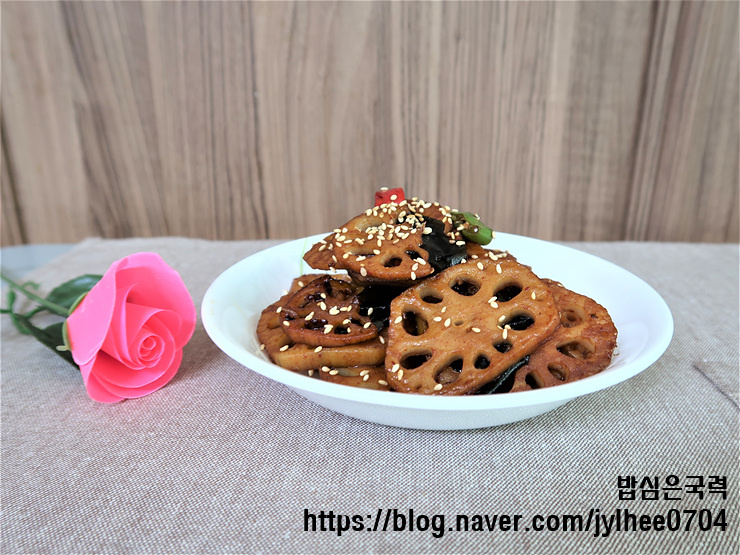Crispy and Chewy Braised Lotus Root
Nutritious and Delicious Braised Lotus Root: A Perfect Side Dish

Lotus root, often called the ‘pearl of the earth,’ is cultivated extensively, even in Buddhist temples, due to its historical association with Buddhism. Its unique sweetness and crisp texture make it a versatile ingredient in Korean cuisine and beyond. It can be prepared in various ways, including tea, deep-fried, soup, steamed, pan-fried, and as a salad. Furthermore, lotus root is renowned for its medicinal properties and health benefits. Rich in carbohydrates, asparagine, and arginine, it’s a great source of Vitamin C, beneficial for relieving fatigue and preventing colds. Today, we’ll be making a delightful braised lotus root that is both crispy and chewy.
Ingredients- 2 Lotus Roots (approx. 400g)
- 1/2 inch Ginger (or 1/2 tsp ginger powder)
- 1 Cheongyang Pepper (Korean spicy pepper)
- 1 Red Bell Pepper
- 10g Dried Kelp (Kombu)
- 2 Tbsp Cooking Oil
- 100ml Water
- 2 Tbsp Brown Sugar
- 4 Tbsp Soy Sauce (Jin Ganjang)
- 2 Tbsp Mirin (Sweet Rice Wine)
- 4 Tbsp Corn Syrup (or Rice Syrup)
- 1 Tbsp Dark Soy Sauce (optional, can be omitted)
- 1/3 Tbsp Fine Gochugaru (Korean chili powder)
- 1 Tbsp Sesame Oil
- Pinch of Toasted Sesame Seeds
Cooking Instructions
Step 1
Did you know that lotus roots have male and female varieties? The slender and long ones are considered ‘male’ and offer a crispier texture, while the plump ones are ‘female’ and provide a chewier bite. Choosing the type you prefer will enhance your braised lotus root experience.

Step 2
Rinse the lotus roots thoroughly under running water. Then, use a vegetable peeler to carefully remove the skin, revealing the beautiful, white flesh underneath.

Step 3
Slice the peeled lotus root into uniform pieces, about 0.5 cm thick. These round slices are not only visually appealing but also absorb the braising liquid beautifully.

Step 4
Fill a pot with ample water, add 2 tablespoons of vinegar, and bring it to a boil. Once boiling, add the sliced lotus root and blanch for 1-2 minutes. The vinegar helps to neutralize any bitterness in the lotus root. Rinsing the blanched lotus root in cold water twice and draining well will further enhance its crispness.

Step 5
Cut the 10g of dried kelp into small square pieces. Kelp adds a delightful chewy texture and a deep umami flavor to the dish. Peel and thinly slice the ginger. If fresh ginger is unavailable, you can substitute it with 1/2 teaspoon of ginger powder.

Step 6
Wash the Cheongyang pepper and red bell pepper, remove their stems, and slice them into rounds. These colorful peppers will add visual appeal to the finished dish.

Step 7
Heat 2 tablespoons of cooking oil in a pan over medium heat. Add the drained lotus root slices, sliced ginger (or ginger powder), and the small pieces of kelp. Sauté for about 3 minutes without burning. This step helps to develop the lotus root’s natural flavors.

Step 8
Pour in 100ml of water. It’s important not to add too much water, as it will prolong the cooking time and dilute the flavor of the braising liquid.

Step 9
Reduce the heat to low and add 2 tablespoons of brown sugar, 4 tablespoons of soy sauce, and 2 tablespoons of mirin. The brown sugar is a key ingredient that provides a subtle sweetness and a rich color to the braised lotus root.

Step 10
Increase the heat to medium and stir occasionally for about 10 minutes, allowing the sauce to thicken and coat the lotus root. You’ll notice a beautiful sheen developing as the brown sugar dissolves.

Step 11
Here’s my special tip for an even richer color: add 1 tablespoon of dark soy sauce. Dark soy sauce is excellent for enhancing the color of dishes without significantly altering the saltiness. If you don’t have dark soy sauce, you can omit this step, but it does add a wonderful depth of color. (It’s readily available at most large supermarkets.)

Step 12
Look at that gorgeous color! Now, add another 2 tablespoons of corn syrup (or rice syrup) to impart a glossy finish and a slightly chewy texture. Continue to simmer over medium heat for another 5 minutes until the sauce is well-reduced and coats the lotus root beautifully.

Step 13
For a touch of subtle spice and unique flavor, add 1/3 tablespoon of fine gochugaru (Korean chili powder). Using fine chili powder ensures a smooth texture and a visually appealing dish, unlike coarse varieties.

Step 14
Add the sliced Cheongyang and red bell peppers to the pan and stir briefly. Finally, drizzle in 1 tablespoon of sesame oil for a fragrant finish and turn off the heat. Sprinkle toasted sesame seeds over the dish once plated for a final flourish.

Step 15
Your crispy and chewy braised lotus root is now complete! The addition of fine gochugaru adds a unique twist. This dish is an excellent side for rice or a perfect addition to lunchboxes. Enjoy this delicious and nutritious treat!



